Shapes, Part I: The Shape of Airpower
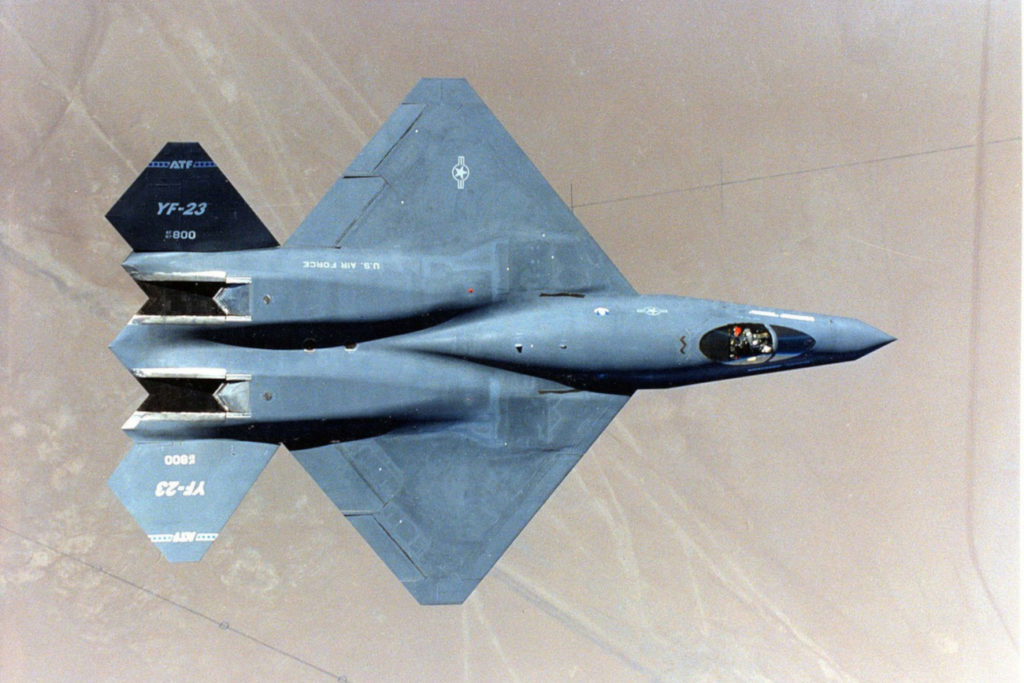
Figure 1: The medium-range stealth strikefighter that should have been: The YF-23 “Grey Ghost” in flight over the Mojave, August 2006 (U.S. Air Force photo)
This is the first in a two-part series, called “Shapes,” which examines the assumptions behind how the Air Force designs its combat aviation at the enterprise level, rather than at the aircraft level. Culturally, airpower advocates are often captured by the possibilities inherent in a specific piece of hardware, rather than the possibilities inherent in a range of airpower capabilities. In reality, what makes airpower useful is not limited to the shape of a specific aircraft – it includes the shape of the whole. What does airpower need to accomplish, in what portion of the world, and against what adversaries? Part II will be titled “The Shape of Strategy.”
The auto industry is built on the idea that one size doesn’t fit all. Even the groundbreaking Ford Model T was developed in a variety of versions, including sedan, roadster, pickup truck, fire engine, and (believe it or not) armored car. The Model T illustrated a longstanding truth: Even for mass-produced vehicles, there is no such thing as the perfect design. Any automotive business, whether a manufacturing or rental company, that tried to sell the idea that one size could fit all possible automotive needs would never get the resources to start up.
Why, then, would we accept the idea that there is only one type of fighter aircraft that would meet all conceivable needs? Counter all possible adversaries? Support a wide variety of war-fighting strategies?
This very argument is playing out today on Capitol Hill, in industry, and in the Pentagon, regarding the controversial purchase of the F-15EX. To some, the purchase is akin to heresy. To others, it makes perfect sense. There are a lot of points that can be considered, but as Mike Benitez has already observed, the decision of what flavor of combat aircraft to buy should be closely tied to strategy. This is exactly right, because having a diversity of strategy options is dependent on what airpower options are available, and that certainly applies to combat aircraft. Maintaining a diversity of combat aircraft, particularly with complementary capabilities, enables war-fighting options that may not be available if we stick to a single design.
But hardware designs aside, context matters. The conditions under which combat aircraft might be used should be a key consideration in how the Air Force shapes a combat aviation enterprise. The use case in the Indo-Pacific theater differs substantially from that in Europe, which is different again from needs in Southwest Asia or Africa. Geography trumps technology.
The Obligatory History and Geography Lesson
If anything has remained constant in modern American military history, it is that the United States has always had to contend with at least two vastly different theaters — the European theater and the Pacific theater. Thus it was in World War II. A single landmass (two if you count North Africa) dominated the European theater, with secure basing available in the United Kingdom even on the worst day. The round trip from 8th Air Force’s bases in East Anglia to Schweinfurt was around 500 miles — only slightly further to Berlin. The B-17 Flying Fortress was designed with a European battlefield in mind. The aircraft had the range to hit targets in Germany, the capacity to carry a useful load, and (so the designers thought), the armament to stave off fighter attacks.
Unfortunately, that last assumption was entirely mistaken. The B-17 was a great aircraft, but the strategy was wrong — it could not fly unescorted in daylight and survive. “Precision” daylight bombing came with a cost — 8th Air Force alone lost more men over Europe than the entire Marine Corps lost in both world wars combined. The “shape” of America’s strategic airpower in Europe was the wrong one, setting up a war of aerial attrition where airpower advocates had hoped for an industrial hammer-blow.
The Pacific was a different ballgame. The Air Force employed the B-17 there, too, but it was the wrong bomber for a different reason. To engage in strategic bombing in the Pacific, the key attributes needed for an airplane are range and payload. The Army Air Corps realized this before the war, and issued a requirement for a really long-range bomber in 1931. Orders for the first B-29 Superfortresses went out a decade later. Even then, an island-hopping campaign was necessary to, first, get close enough to Tokyo and, second, get closer to provide emergency airfields for damaged Superfortresses. The shape of airpower needed in the Pacific Theater differed substantially from what Europe needed. That may well be a constant: Airpower requirements have always been different between these two theaters.
There was overlap, of course. The B-25 Mitchell was a medium bomber that saw heavy use in both theaters. But even here, the aircraft, and their uses, differed substantially. On the Pacific front, the B-25 Mitchell was heavily modified for anti-shipping strikes, often carried out at wave-top height using “skip bombing,” whereby a bomb was intentionally skipped across the water to slam into the hull of a Japanese ship. This necessitated different tactics, and a different nose, from the B-25s used in North Africa and Europe. Those modifications eventually found their way to aircraft in Europe, and European experience also affected B-25 operations in Burma, where the aircraft were used to haul cargo as well.
Similarly, the P-38 Lightning, a long-range fighter, served well in both theaters. The long range was particularly notable when the aircraft was to shoot down a bomber carrying Admiral Yamamoto. Notably, the P-38’s requirements, initially intended to produce a long-range fighter, went directly against the prevailing Army Air Corps wisdom that disdained long-range, high-altitude fighters as unnecessary — similar to the current Air Force line that non-stealthy aircraft are undesirable.
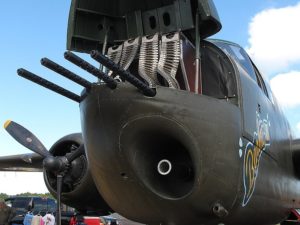
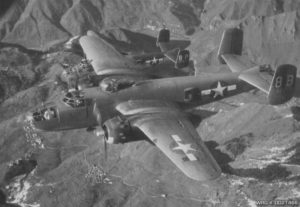
Figure 2: The New Guinea nose on “Barbie III,” a restored B-25 — four .50 cal guns and a 75mm cannon that was originally hand-loaded by the crew. On the right, a pair of glass-nose B-25s of the 340th Bomb Group, 12th Air Force over the Italian Alps en route to a target in the Brenner Pass, 1944. (Left photo under license by Ssaco, right photo by U.S. Air Force)
Range and Payload, Baby
Several years ago, in The Comanche and the Albatross, I advocated the cancellation of the F-35 program. That particular piece of rank heresy got me chewed out more than any of my other writings, even to the point where a Reserve two-star wanted to issue a letter of reprimand (he didn’t). My objections centered around the cost, of course, but I also noted that:
the mission of the aircraft—to penetrate the most advanced air defenses and drop precision-guided munitions on critical targets of a peer adversary—remains questionable at best, especially if that peer is located in the Indo-Asia-Pacific region, where basing is limited, ranges are long, and potential adversaries have logistical advantages.
Today, I’ve come to the reluctant conclusion that the aircraft may be useful in the European theater against a Russian adversary that is still conditioned to fear penetrating airpower. But the geography in the Pacific hasn’t changed since 1945 — which places a premium on range and payload that the F-35 just doesn’t have. The F-35 (when it flies) may be a pilot’s dream, but that dream is based on the advanced sensors and displays installed on the aircraft — displays and sensors that can just as easily be installed on any other fighter, including refitted, non-stealthy aircraft. Displays and sensors that modern, fourth-generation aircraft have as well.
The so-called “fifth-generation aircraft” make their money on low-observability features, commonly known as “stealth.” Those features rely heavily on the shape of the aircraft, which places two very important limitations on a plane that wants to retain its low observability: The shape of the aircraft cannot be changed, and if external stores are carried, they must also be stealthy. In this way, a fifth-generation fighter trades away an increased range and payload for stealth. This makes modifications difficult — change the shape, and the stealth changes. Fifth-generation aircraft can also carry some external weapons, but this tends to totally compromise the shape as well as add drag.
Fourth-generation aircraft are not stealthy. They are festooned with sharp angles and pointy bits, anathema to a stealth aircraft design. But these aircraft also have the ability to haul a vast array of ordnance, including large weapons that the fifth-generation fighters will never carry. They are easy to modify, and changing the shape is of little concern. Want a new Infrared search-and-track system? Stick it on. A better radar for ground imaging? Put it in a pod and clamp it on the centerline. An improved targeting pod? Done. Laser trackers, tactical electronic support measure sensors, and friend-or-foe interrogators have all been, quite literally, stuck onto fourth-generation aircraft. Moreover, the array of ordnance these aircraft can and have carried is staggering. The newest versions of these fighters — originally designed in the 1970s — can and will match the next generation of onboard systems and displays, giving these aircraft “fifth-generation” systems in an advanced fourth-generation shell.
Still, let’s face it: Comparing airframes is a game for hobbyists, model-builders, and tacticians. It reveals little about the necessary shape of airpower, which is determined far more by the nature of the desired strategy and the prevailing geography.
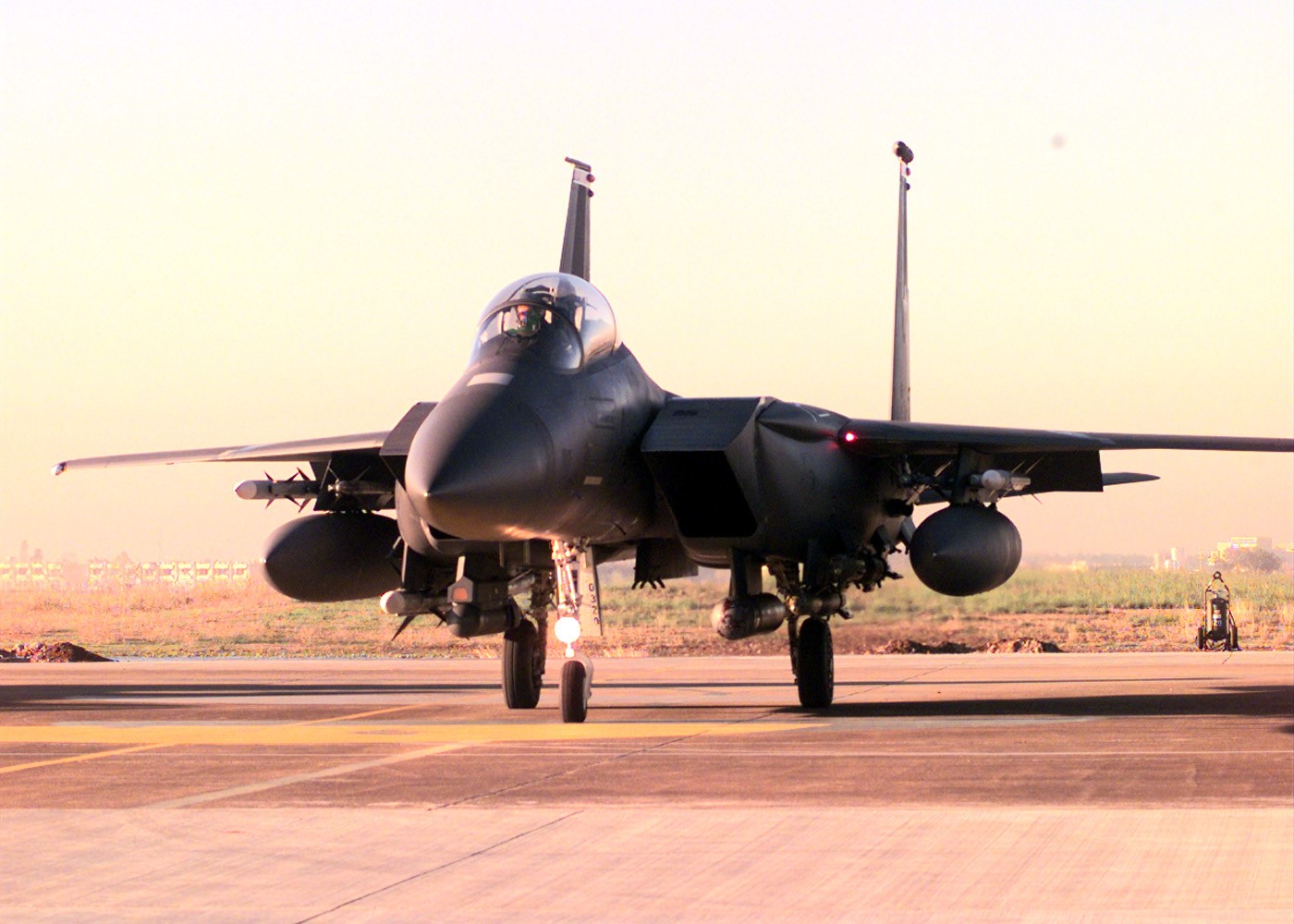
Figure 3: Lt. Col. Al “Bat” Cross and Capt. Mike “Starbaby” Pietrucha of the 494th Fighter Squadron await takeoff clearance at Incirlik Air Base on December 30, 1999. The aircraft is armed with LANTIRN targeting and navigation pods, two GBU-12 laser guided bombs, two external fuel tanks, an M61A1gun with 510 rounds of ammunition, and six air-to-air missiles – two each AIM-9 Sidewinder, AIM-120A AMRAAM, and AIM-7M Sparrow. (U.S. Air Force Photo)
The Strategy Conundrum
Just as designers constructed and fielded the B-17 with the idea that “the bomber will always get through,” the F-35 relies on an equally faith-based belief that “the stealth fighter will always get through.” Putting aside the fact that neither statement is true if the aircraft doesn’t have the range to get to the target, both statements rely on an unproven philosophy of airpower that dates back to Giulio Douhet. The need to penetrate airspace is driven by a perceived need to hit “strategic” targets to help defeat the adversary, who will fold if the aggressor can just apply airpower in the correct fashion.
The problem with these theories is that the Air Force has tried them before, and their effectiveness remains in dispute. While the idea of bombing a country “back to the Stone Age” is a great bumper sticker, it’s a lousy conventional strategy — because it cannot be done conventionally. The Air Force can level a mid-sized city, of course, but it can no longer deliver the weight of ordnance that the massed air forces of World War II could deliver. In World War II, the Army Air Corps and Royal Air Force could independently muster 1,000-bomber raids, including a mammoth 1,400-bomber raid in 1945; today’s Air Force has far less capacity. And while the United States devastated Japan by air attack, maritime interdiction affected Japan even more, starving Japanese industry of resources before the B-29s arrived.
The Air Force has since adopted a target-centric worldview that treats hostile entities as if they are subject to a “first-ring” strategy that will magically cause enemies to capitulate when airpower is applied. That didn’t even work in Iraq the first time around. The Air Force’s use of precision weapons may have blinded it to the limits of airpower in affecting regime change — particularly against a regime that has proven remarkably resistant. If we think we’re going to bomb China into submission with precision weapons, we’re deluding ourselves. A modern country of China’s size and sophistication is simply not brought to its knees by any flavor of conventional war. Stalin’s Russia wasn’t. Churchill’s British Empire wasn’t. Chiang Kai-Shek’s China resisted a much more powerful Japan. Japan, Germany, and Italy succumbed to physical occupation of their territories and the destruction of their military forces — options not available against China.
That doesn’t mean there are no viable war-fighting strategies. As I’ve pointed out before, China is an island nation, and one with unfavorable geography to boot. We don’t think of it as an island nation, because it doesn’t have water all around it, but its terrain is forbidding. If China is to import necessary materials, export products, or project power that might threaten U.S. interests, it must do so in or over the maritime domain. The land routes are bedeviled with difficult terrain and a limited ability to haul goods — Shanghai can move more tonnage into its port in less than 60 days than all of China’s land routes move in a year. This dependence on maritime traffic opens the country up to a repeat of the counter-maritime strategy that ended Japan’s East Asian Co-Prosperity Sphere in 1945 — provided the U.S. military has the proper forces to execute it. The way to deal with China realistically is to focus on limiting its ability to project power (which may be achievable) rather than seeking victory through strategic bombing (a pipe dream). That requires range and payload.
Of course, China is hardly the only adversary the Air Force should be prepared to fight, and the Pacific is not the only theater. Russia threatens U.S. interests, posing a powerful land-based threat to Europe and an emerging expeditionary threat elsewhere. Iran looms large over the Persian Gulf, posing the twin problem of long distances and a lack of friendly border countries for the most part. A nuclear-armed North Korea is still technically at war with South Korea, sitting atop some of the most rugged terrain in North Asia. And the violent extremist threat has in recent years required airpower employment in Africa and Southwest Asia. The prevalence of violent extremists combined with their widespread distribution means the end of the constant rotational presence that has devastated Air Force readiness is nowhere in sight. With a variety of challenges comes the need for a variety of response options.
The Shape of Airpower
As a smart investor relies on a diversified portfolio, so to must the airpower strategist rely on a diversified set of airpower options. The Air Force does actually do this when it comes to bombers: It currently has three models of bomber, with the B-2 optimized for stealth, the B-1 for heavy conventional loads, and the long-serving arsenal plane, the B-52, possessing unmatched — you guessed it — range and payload. We have the C-17, C-130, and C-5 all providing airlift. The KC-135, KC-46, and KC-10 refuel other aircraft in flight. The idea that the F-35 would replace the F-16 and A-10 (vastly different aircraft) was fanciful at the beginning, and it hasn’t gotten any more viable with age.
A procurement strategy that limits the Air Force to a single model of fighter denies the nation a diversified set of airpower capabilities and closes off the use of unique options against a major power. It almost seems as if the Air Force is stuck in the 1980s, when the Soviet threat loomed large over Europe, and the Chinese military was still focused on mass over technology. The long-awaited “pivot” to the Indo-Pacific region with airpower capabilities looks to be a repeat of the focus on irregular warfare required by simultaneous conflict in Iraq and Afghanistan — a focus that never actually came to fruition and instead resulted in a misuse of high-end airpower capabilities for low-intensity operations for more than two decades. A similar condition prevails today: Airpower capabilities designed for one theater and one adversary are applied where they do not fit, in defiance of historical evidence.
The Air Force needs to regain a diversified force, optimized for a variety of conflicts. This diverse force should acknowledge the nature of the most capable adversaries (Russia and China) and the widely differing geography that comes with each. The Air Force has belatedly realized that it should have bought more F-15s, and with the F-15EX, proposes to buy the most advanced variant of what is, inarguably, a world-class fighter. It’s a poor reflection on the state of discourse about airpower if it devolves into an argument of which fighter is “better.” Better for what? Where? Range and payload, baby.
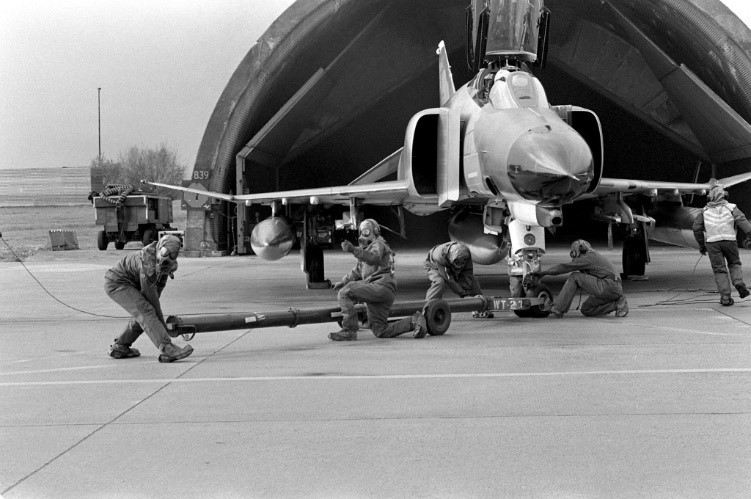
Figure 4: If any aircraft has claim to the “one-size-fits-all” label it was the Mighty F-4 Phantom. And even that would be wrong. The A-7D could carry more, the F-111 could go faster and further, the F-5 could turn tighter, and the MiG-21 was easier to maintain. Here a ground crew prepares an F-4E for a push-back into a hardened shelter at Hahn Air Base, Germany, in SALTY MACE ’80. (U.S. Air Force photo by Staff Sgt. Mary Andrews)
Col. Mike “Starbaby” Pietrucha was an instructor electronic warfare officer in the F-4G Wild Weasel and the F-15E Strike Eagle, amassing 156 combat missions over 10 combat deployments. He is the last American aviator to reach 1000 hours operationally in the mighty Phantom II. As an irregular warfare operations officer, Col. Pietrucha has two additional combat deployments in the company of U.S. Army infantry, combat engineer, and military police units in Iraq and Afghanistan. He is currently assigned to Air Combat Command. The views expressed are those of the authors and do not necessarily reflect the official policy or position of the Department of the Air Force or the U.S. Government.
Image: U.S. Air Force

